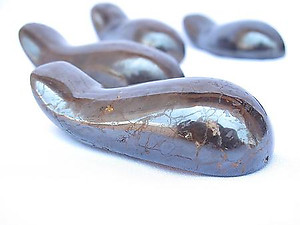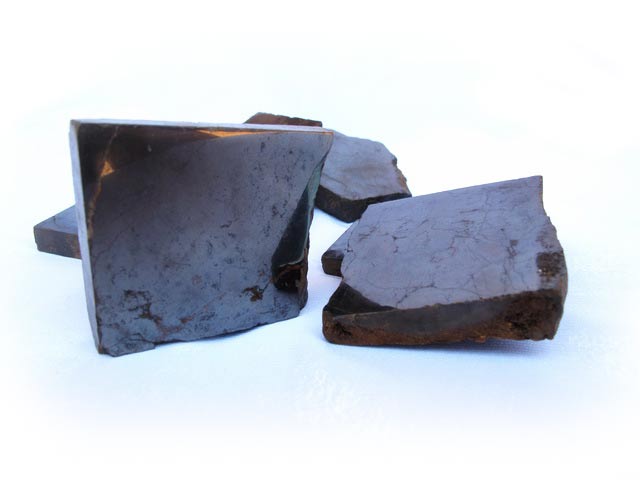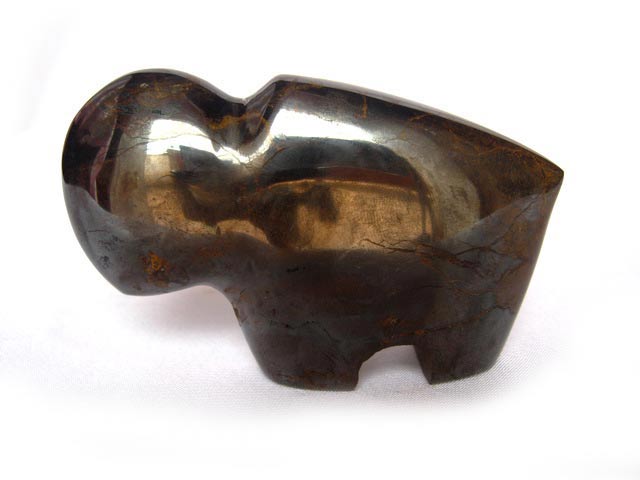Metaphysical guide of Hematite, Physical properties of Hematite
|
HEMATITE Hematite, also spelled as hæmatite, is the mineral form of iron (III) oxide (Fe2O3), one of several iron oxides. Hematite crystallizes in the rhombohedral system, and it has the same crystal structure as ilmenite and corundum. Hematite and ilmenite form a complete solid solution at temperatures above 950°C. Hematite is a mineral, colored black to steel or silver-gray, brown to reddish brown, or red. It is mined as the main ore of iron. Varieties include kidney ore, martite (pseudomorphs after magnetite), iron rose and specularite (specular hematite). While the forms of hematite vary, they all have a rust-red streak. Hematite is harder than pure iron, but much more brittle. Maghemite is a hematite- and magnetite-related oxide mineral. Huge deposits of hematite are found in banded iron formations. Grey hematite is typically found in places where there has been standing water or mineral hot springs, such as those in Yellowstone National Park in the United States. The mineral can precipitate out of water and collect in layers at the bottom of a lake, spring, or other standing water. Hematite can also occur without water, however, usually as the result of volcanic activity. Clay-sized hematite crystals can also occur as a secondary mineral formed by weathering processes in soil, and along with other iron oxides or oxyhydroxides such as goethite, is responsible for the red color of many tropical, ancient, or otherwise highly weathered soils. The name hematite is derived from the Greek word for blood ???? haima, due to the red coloration found in some varieties of hematite. The color of hematite lends itself to use as a pigment. The English name of the stone is derived from Middle French: Hématite Pierre, which was imported from Latin: Lapis Hæmatites around the 15th century, which originated from Ancient Greek: ????????? ????? (haimatit?s lithos, "blood-red stone"). Ochre is a clay that is colored by varying amounts of hematite, varying between 20% and 70%. Red ochre contains unhydrated hematite, whereas yellow ochre contains hydrated hematite (Fe2O3 • H2O). The principal use of ochre is for tinting with a permanent color. The red chalk winning of this mineral was one of the earliest in history of mankind. The powdery mineral was first used 164,000 years ago by the Pinnacle-Point man obviously for social differentiation. Hematite residues are also found in old graveyards from 80,000 years ago. Near Rydno in Poland and Lovas in Hungary, palaeolitic red chalk mines have been found that are from 5000 BC, belonging to the Linear Pottery culture at the Upper Rhine. Rich deposits of hematite have been found on the island of Elba that has been mined till the time of the Etruscans. Hematite`s popularity in jewelry was at its highest in Europe during the Victorian era, and has since seen a strong resurgence in North America, especially in the western United States Hematite is present in the waste tailings of iron mines. A recently developed process, magnetation, uses huge magnets to glean waste hematite from old mine tailings in Minnesota`s vast Mesabi Range iron district. Hematite on Mars:
The spectral signature of hematite was seen on the planet Mars by the infrared spectrometer on the NASA Mars Global Surveyor ("MGS") and 2001 Mars Odyssey spacecraft in orbit around Mars. The mineral was seen in abundance at two sites on the planet, the Terra Meridiani site, near the Martian equator at 0° longitude, and the second site Aram Chaos near the Valles Marineris. Several other sites also showed hematite, e.g., Aureum Chaos. Because terrestrial hematite is typically a mineral formed in aqueous environments, or by aqueous alteration, this detection was scientifically interesting enough that the second of the two Mars Exploration Rovers was targeted to a site in the Terra Meridiani region designated Meridiani Planum. In-situ investigations by the Opportunity rover showed a significant amount of hematite, much of it in the form of small spherules that were informally named "blueberries" by the science team. Analysis indicates that these spherules are apparently concretions formed from a water solution. Physical properties of Hematite: Color: Steel Gray, Metalic Gray, Black, Rusty Red Rarity: Very Common Fun Fact: In ages past Hematite was used as a mirror. Category Oxide mineral Chemical formula iron(III) oxide, Fe2O3, ?-Fe2O3 Identification Crystal habit Tabular to thick crystals Crystal system Trigonal - hexagonal scalenohedral Cleavage None Fracture Uneven to sub-conchoidal Mohs scale hardness 5.5 - 6.5 Luster Metallic to splendent Streak Bright red to dark red Specific gravity 4.9 - 5.3 Refractive index Opaque Pleochroism None Location: Worldwide including Bolivia, Brazil, Canada, India, Madagascar, Namibia, Russia, South Africa, UK, USA Metaphysical guide of Hematite:
Grounding, Balancing, Detoxifying Primary Chakras: ALL especially Root and Solar Plexus Astrological signs: Aries, Aquarius Primary Chakra: ALL especially Root and Solar Plexus Astrological sign(s): Aries, Aquarius Vibration: Number 9 Stone Type/Family: A member of the Hematite Group Crystal System: Hexagonal Chemical Composition: (Fe2O3) Iron Oxide Hardness: 5-6 Hematite helps to absorb negative energy and calms in times of stress or worry. Hematite is a very protective stone and is great to carry to help you stay grounded in many situations. Hematite is also good for working with the Root Chakra, helping to transform negative energies into a more positive vibration. Those in relationships can benefit from the cooperation vibe coming from Hematite.
Hematite can help one to find their own, unique gifts and to release self-imposed limitations, while still maintaining a healthy amount of self-control. Hematite aids in the Ascension process, by facilitating the integration of higher spiritual energies into our physical 3-D existence. This allows those who are doing spiritual work to still be able to function in the physical world and relate to others. Carry Hematite when in need of balance and equilibrium, or when having difficulty focusing energies. Hematite is also said to be useful in legal situations, and is thought to strengthen self-confidence. Meditation with Hematite can integrate the higher energies of the spirit into the physical 3D world. Physically, Hematite is also used to protect against geopathic stress and electromagnetic smog, and is said to be a great detoxifying stone, helpful for the liver and the blood. This information does not intend to serve as medical advice, cure any diseases, and should not be relied upon in your health-related decision making. This information is available to assist in expanding your understanding of prevailing beliefs in the metaphysical fields. |
The Hematite products that may help you


